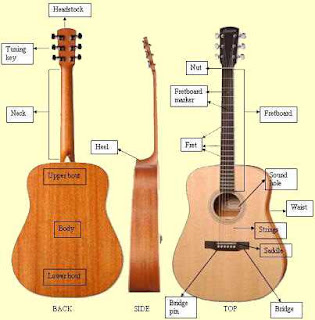Main article: Fingerboard
Also called the fingerboard, the fretboard is a piece of wood embedded with metal frets that comprises the top of the neck. It is flat on classical guitars and slightly curved crosswise on acoustic and electric guitars. The curvature of the fretboard is measured by the fretboard radius, which is the radius of a hypothetical circle of which the fretboard's surface constitutes a segment. The smaller the fretboard radius, the more noticeably curved the fretboard is. Most modern guitars feature a 12" neck radius, while older guitars from the 1960s and 1970s usually feature a 6-8" neck radius. Pinching a string against the fretboard effectively shortens the vibrating length of the string, producing a higher pitch. Fretboards are most commonly made of rosewood, ebony, maple, and sometimes manufactured or composite materials such as HPL or resin. See below on section "Neck" for the importance of the length of the fretboard in connection to other dimensions of the guitar.

Frets
Main article: Fret

Frets are metal strips (usually nickel alloy or stainless steel) embedded along the fretboard and located at exact points that divide the scale length in accordance with a specific mathematical formula. Pressing a string against a fret determines the strings' vibrating length and therefore its resultant pitch. The pitch of each consecutive fret is defined at a half-step interval on the chromatic scale. Standard classical guitars have 19 frets and electric guitars between 21 to 24 frets (though Caparison Guitars issue guitars with as many as 27 frets.[19])
Frets are laid out to a mathematical ratio that results in equal tempered division of the octave. The ratio of the spacing of two consecutive frets is the twelfth root of two. The twelfth fret divides the scale length in two exact halves and the 24th fret position divides the scale length in half yet again. Every twelve frets represents one octave. In practice, luthiers determine fret positions using the constant 17.817, which is derived from the twelfth root of two (21/12). The scale length divided by this value yields the distance from the nut to the first fret. That distance is subtracted from the scale length and the result is divided in two sections by the constant to yield the distance from the first fret to the second fret. Positions for the remainder of the frets are calculated in like manner.[20] Actual fret spacing does not use this exact value; the fret spacing on the fretboard was also done by trial and error (testing) method over the ages.
There are several different fret gauges, which can be fitted according to player preference. Among these are "jumbo" frets, which have much thicker gauge, allowing for use of a slight vibrato technique from pushing the string down harder and softer. "Scalloped" fretboards, where the wood of the fretboard itself is "scooped out" between the frets allows a dramatic vibrato effect. Fine frets, much flatter, allow a very low string-action but require other conditions such as curvature of the neck to be well maintained in order to prevent buzz.
On steel-string guitars, frets are eventually bound to wear down; when this happens, frets can be replaced or, to a certain extent, leveled, polished, recrowned, or reshaped as required.
Truss rod
Main article: Truss rod
The truss rod is a metal rod that runs along the inside of the neck. It is used to correct changes to the neck's curvature caused by the neck timbers aging, changes in humidity or to compensate for changes in the tension of strings. The tension of the rod and neck assembly is adjusted by a hex nut or an allen-key bolt on the rod, usually located either at the headstock, sometimes under a cover, or just inside the body of the guitar underneath the fretboard and accessible through the sound hole. Some truss rods can only be accessed by removing the neck. The truss rod counteracts the immense amount of tension the strings place on the neck, bringing the neck back to a straighter position. Turning the truss rod clockwise will tighten it, counteracting the tension of the strings and straightening the neck or creating a backward bow. Turning the truss rod counter-clockwise will loosen it, allowing string tension to act on the neck and creating a forward bow. Adjusting the truss rod affects the intonation of a guitar as well as the height of the strings from the fingerboard, called the action. Some truss rod systems, called "double action" truss systems, tighten both ways, allowing the neck to be pushed both forward and backward (standard truss rods can only be released to a point beyond which the neck will no longer be compressed and pulled backward).
Classical guitars do not require truss rods as their nylon strings exert a lower tensile force with lesser potential to cause structural problems. However their necks are often reinforced with a strip of harder wood, such as an ebony strip running down the back of a cedar neck. There is no tension adjustment on this form of reinforcement.
0 comments:
Post a Comment